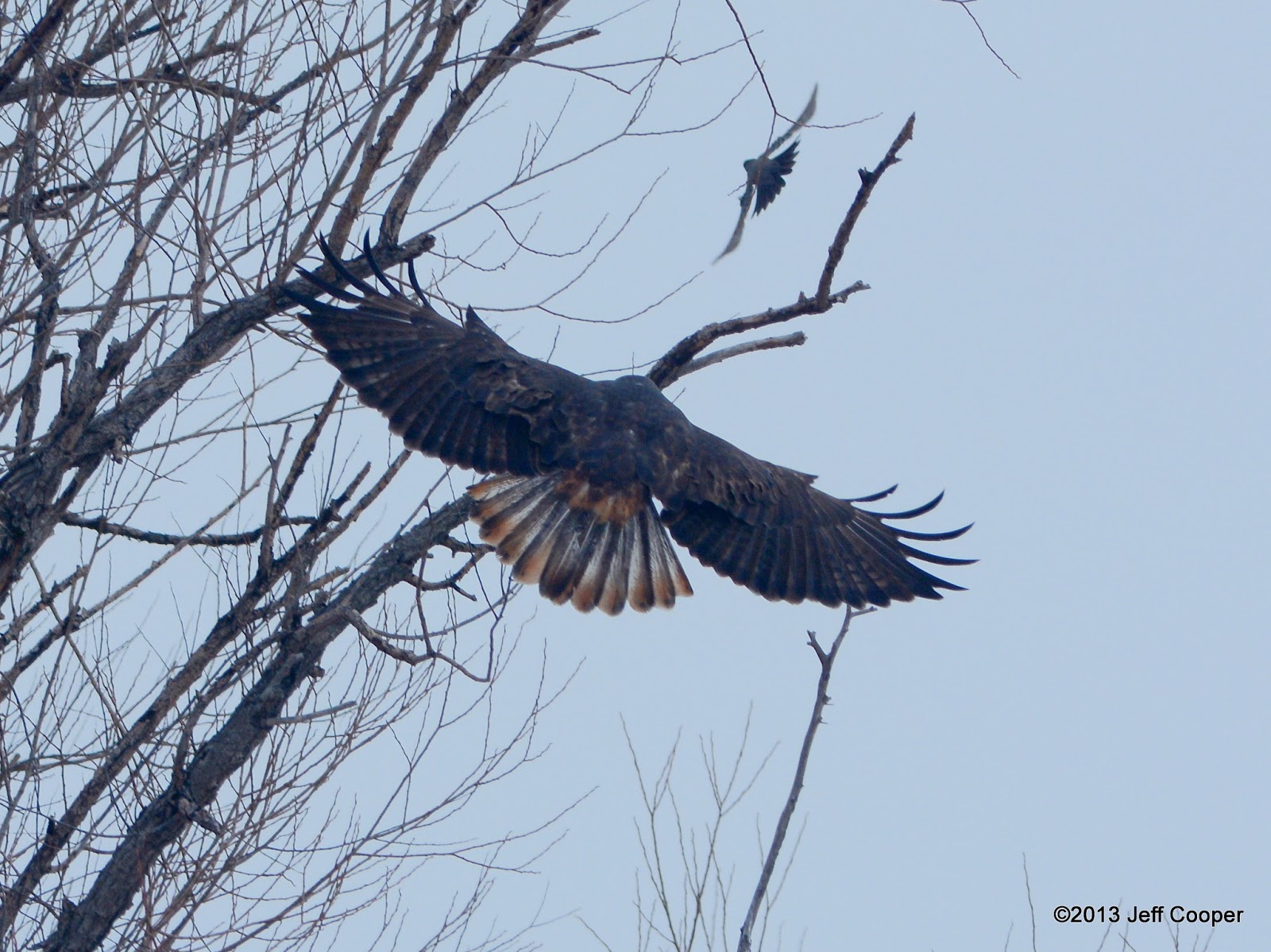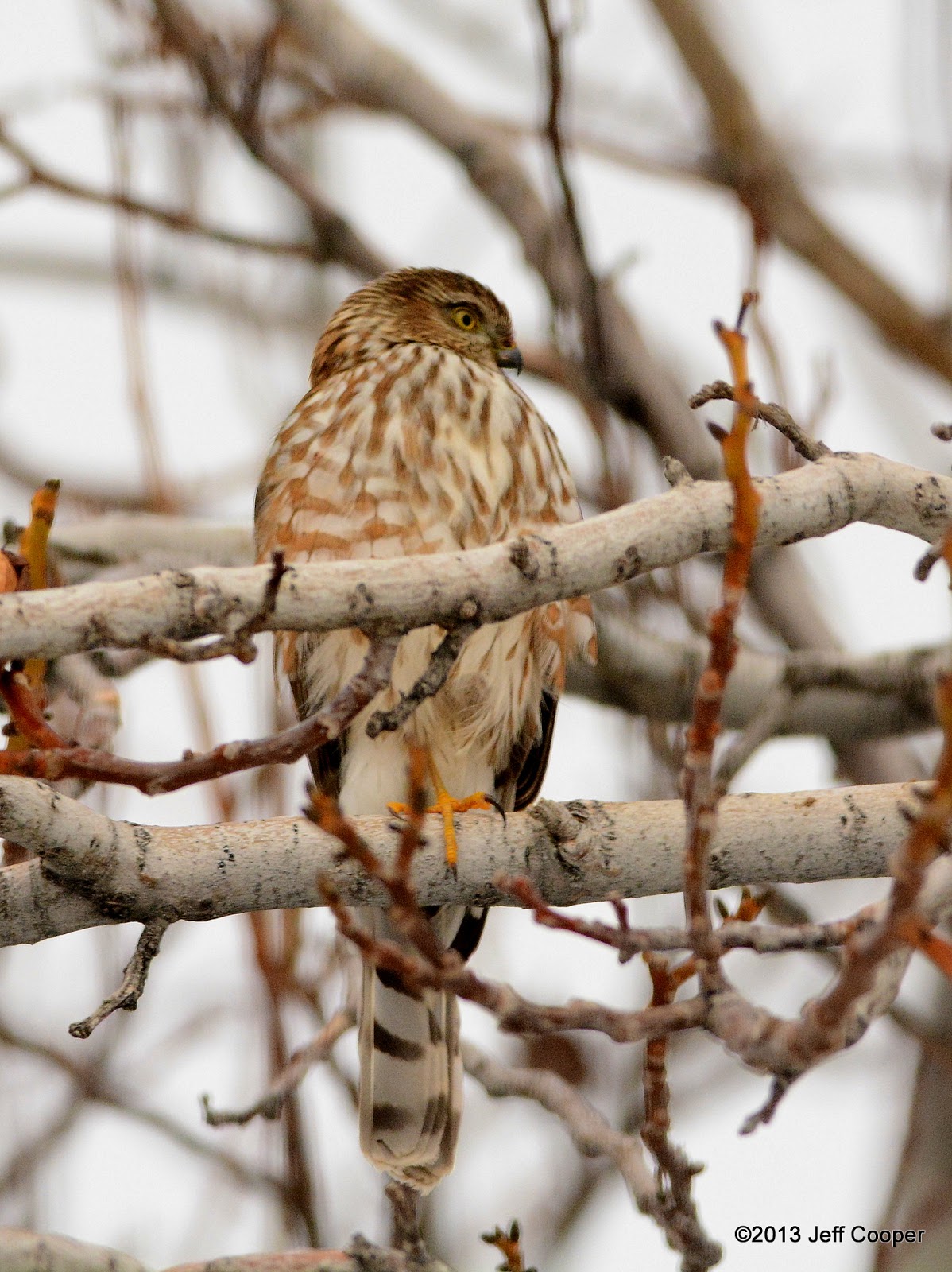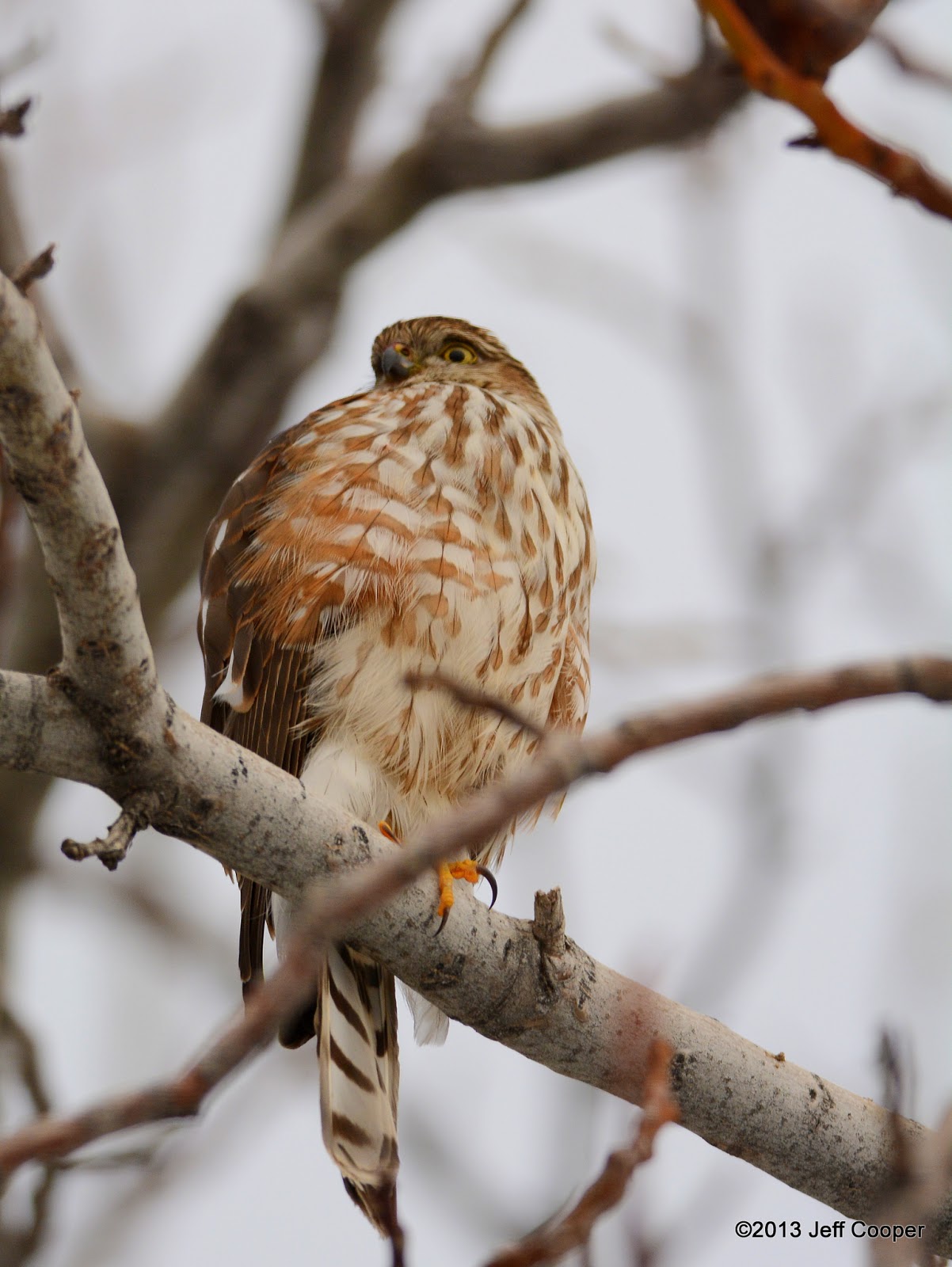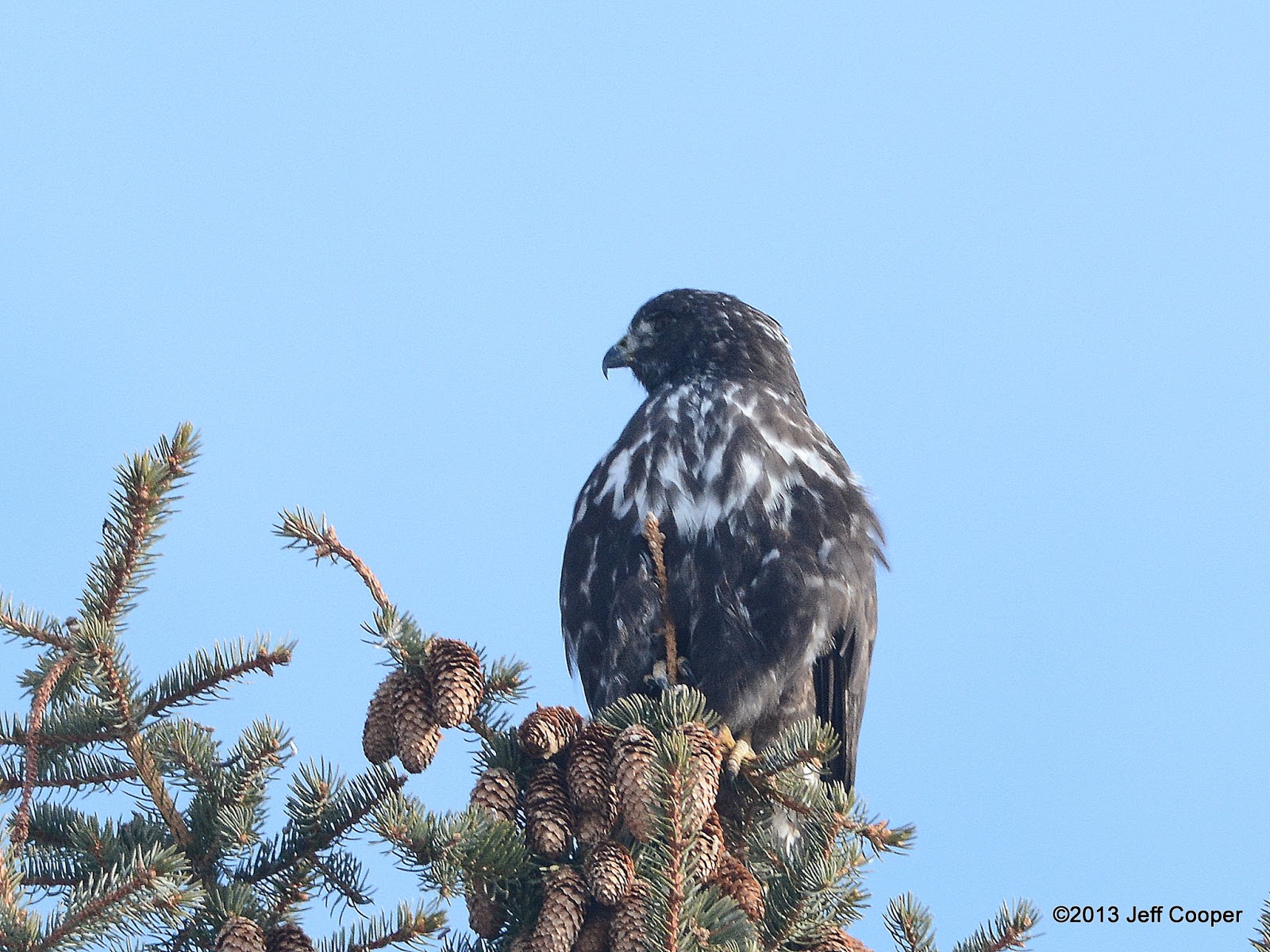Winter and cruising for raptors are a great combination, even if we are stuck in another "inversion", as was the case Saturday in Utah County. For those who don't know, an inversion occurs when we have high pressure sitting on top of our valleys and we become very aware of how much pollution we are putting out because it can't escape and dissipate into the skies above us. Smog simply builds up and severely limits sunlight and visibility. It's definitely not good for our health and is not ideal for long lens photography. However, I still make the most of what I can on my Saturday excursions.
My family and friends know that, for me, spending a couple of hours cruising the fields and open spaces of Utah County in my Toyota Tacoma on a Saturday morning or afternoon is hard to beat for getting a weekly boost of love for life and our amazing world. I've shared this before, but spotting a raptor in a naked deciduous tree is the start of what can turn into an exciting experience. Could it be a rare hawk? Which accipiter is that? Is that my first Bald Eagle of the season way over there? These are just a few of the questions that come into my mind and beg for an answer through further exploration and discovery. Well, I got my weekly fix Saturday after cleaning house and shopping for groceries and before assembling furniture with one of my sons.
Lehi has been a very productive area for me over the past couple of years in terms of raptor watching so I made my way around a number of its open fields and yet-to-be developed areas. One of my first discoveries was yet another Harlan's Hawk, or "Harlie"
as some raptor folks call them. I believe we have more in Utah than local birders realize during our winter months, but I don't think birders are investigating deep enough to separate them from our usual Western Red-tailed Hawks. I'm trying to change that by documenting and sharing my sightings. You can learn more about the Harlan's race of Red-tailed Hawks by
clicking here to see a post I did as winter was approaching and it was time to start looking for them to arrive from Alaska and the Yukon area again. I've already located four Harlan's Hawks in Utah County during this winter season so the one below becomes number five. I first noticed a hawk flying in the distance, put my binoculars on it, and caught a quick glimpse of what looked like more of a grayish rather than red color on the top side of the tail. That's a sure sign of an adult Harlan's Hawk, an expected red tail altered with whitish, grayish, or darkish coloring. I drove a maze of streets and relocated the hawk perched above a field next to a home.
 |
| Adult Harlan's Red-tailed Hawk Lehi, UT |
The hawk flew a short distance across the field just as I pulled off to the side of the road and landed in another tree, scaring off some smaller birds. Harlies seem very skittish and tend to flush at distances greater than Western Red-tailed Hawks. Colors on this hawk are muted due to the lack of sunlight and the haze. However, you can see the grayish upperside to the tail, the typical white streaking on the chest, and some mottling in the wings. Some remiges (wing or flight feathers) show little to no banding, another trait for adult Harlan's Hawks. The dark terminal band or border in the wings is indicative of an adult bird. Young birds don't show that dark terminal band in the wings. One other field mark I noticed about this Harlan's that I have yet to see on other Harlan's Hawks I've observed in the past few years is the rufous, rather than dark, colored undertail coverts.
 |
| Adult Harlan's Red-tailed Hawk Lehi, UT |
 |
| Adult Harlan's Red-tailed Hawk Lehi, UT |
This image shows the tell-tale sign of an adult Harlan's Hawk--a tail that includes any combination of red, gray, white, and/or black.
 |
| Adult Harlan's Red-tailed Hawk Lehi, UT |
 |
| Adult Harlan's Red-tailed Hawk Lehi, UT |
 |
| Adult Harlan's Red-tailed Hawk Lehi, UT |
 |
| Adult Harlan's Red-tailed Hawk Lehi, UT |
After observing and photographing the Harlie I noticed a Sharp-shinned Hawk (Sharpie) perched in a tree in the back yard of the home next to the field. The homeowner was preparing to hang some Christmas lights. We visited briefly and I told him about the Sharpie in his back yard. We both walked to the back of the house and talked about how lucky he was to have these two birds right in his yard--I wish I could add a Harlan's Hawk to my yard bird list. As we talked the homeowner pointed farther down his property to show me that his son had put out bird feeders. That's when I realized why the Sharpie was waiting patiently in the cover of the tree--he was waiting to ambush and eat an unsuspecting bird when it came to the feeders. I'm not sure how it happened between photographing the Harlie and the Sharpie, but the white balance on my camera went from the "cloudy" to the "incandescent" setting. Below is the result of that minor mishap--definitely not my desired outcome in terms of color.
 |
| Juvenile Sharp-shinned Hawk Lehi, UT |
Fortunately, I checked my initial images on the display and noticed the problem. As I was looking down at the camera to make the adjustments to the white balance the hawk left its perch and made a weak attempt at chasing another bird. It re-established a perch to watch the feeders. I captured the images below as it waited. The smoothly rounded and downward sloping crown and smallish bill shown in the image below are traits of a Sharpie. The larger and similar-looking Cooper's Hawk would show more of an angular or blocky looking head profile, possibly with a more squared crown. Sharpies never show a raised crown. Coarse, rather than more thin dark, streaking is a Sharpie trait. The brown back and yellow eyes indicate a young bird, but you can see adult-like plumage on the belly (rufous barring) along with juvenile plumage on the chest and nape (brown streaking). I was able to compare the size of the hawk to a nearby Brewer's Blackbird and ventured a guess that it was a male since it was relatively small, about 9-10 inches from head to tip of tail. Males are smaller than females. This hawk's tail feathers are worn at the tips so using tail tip shape and length of outer tail feathers alone is not a good way to distinguish between a Sharp-shinned and a Cooper's Hawk.
 |
| Juvenile Sharp-shinned Hawk Lehi, UT |
 |
| Juvenile Sharp-shinned Hawk Lehi, UT |
 |
| Juvenile Sharp-shinned Hawk Lehi, UT |
This is the classic "small head with bug eyes" appearance that many people associate with Sharp-shinned Hawks. I like seeing the mix of juvenile and adult plumage again on this fierce little hawk.
 |
| Juvenile Sharp-shinned Hawk Lehi, UT |
I could tell the Sharpie had food in its crop (bulging chest feathers on its left side) and some blood on the cere (skin at top of bill next to forehead). Apparently, however, it was still hungry because it dove right over my head and took out a House Sparrow in another yard. I watched it chase the poor sparrow through bushes before killing it inside an evergreen. I was not able to see anything from that point on so I thanked the homeowner and made my way to other fields in Lehi.
I checked on the location for another Harlan's I'd observed in recent weeks. It was occupying its previous perch. I captured some images of that bird as it stretched its tail feathers. I'd been wanting to see this birds tail pattern for a couple of weeks. After a couple of minutes the hawk flew just to my left and over my head. The lighting, again, was poor, but the field marks for identifying these hawks can be seen in these images--overall dark Red-tailed Hawk with white streaking in the chest, mottling in the tail and wings, many flight feathers showing little to no barring (an adult Harlan's trait) on the underside.
 |
| Adult Harlan's Red-tailed Hawk Lehi, UT |
 |
| Adult Harlan's Red-tailed Hawk Lehi, UT |
 |
| Adult Harlan's Red-tailed Hawk Lehi, UT |
 |
| Adult Harlan's Red-tailed Hawk Lehi, UT |
 |
| Adult Harlan's Red-tailed Hawk Lehi, UT |
 |
| Adult Harlan's Red-tailed Hawk Lehi, UT |
 |
| Adult Harlan's Red-tailed Hawk Lehi, UT |
This is the same bird as above after it landed on an evergreen. White streaking can also be seen in the head.
 |
| Adult Harlan's Red-tailed Hawk Lehi, UT |
On my way home I passed my third Harlie of the day. It was perched in a tree far from the road, but I'll finish this "Harlie, Sharpie, Harlie, Harlie" post with one image of the third Harlie of the day--gotta be true to the title of the post. This one had a fairly white chest, but that is not shown in this particular image since we are looking at its back. It had a mostly dark brown/black tail. It's hard to see in the image, but this one also has white feathers at the bridge of the bill, another Harlie trait.
 |
| Adult Harlan's Red-tailed Hawk Lehi, UT |
I'm looking forward to discovering more Harlies in the coming months and I'm really hoping to get good looks at a Northern Goshawk this winter. That would be a real treat for this raptor-loving birder.